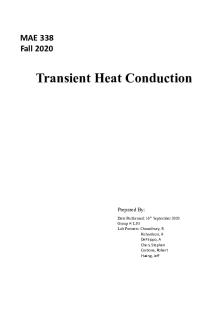Englab - report PDF

| Title | Englab - report |
|---|---|
| Author | Ishraqul Aranya |
| Course | Engineering Lab I |
| Institution | LaGuardia Community College |
| Pages | 4 |
| File Size | 156.7 KB |
| File Type | |
| Total Downloads | 51 |
| Total Views | 156 |
Summary
report...
Description
Objective: The objective of this experiment is to study the fatigue phenomenon for a simple structural number. Introduction: Fatigue failure is defined as the tendency of materials to fracture by means of progressive brittle cracking under repeated alternating or cyclic stresses of intensity considerably below the normal strength. The number of cycles required to because fatigue is increased at a particular peak stress is generally quite large, but it decreases as the stress is increased. Fatigue cycles can be applied to a part and the part will not have a crack. When the part has the received enough cycle loads, then it will initiate a crack. Continued cycle load applications will cause the crack to grow to failure. Apparatus: 20 Paper clips Experimental set up:
Procedure: In the fatigue failure experiment we straighten out twenty paper clips and select a point when it was not bent before. Then we start turning paper clip at that point to the left and right about 30 degrees and repeated this procedure until it broke into two. We count the number of circle it took to break. We did the same thing for the rest of the paper clips. Experimental Data: Paper clip No# 1 2 3 4 5 6 7 8 9 10 11 12 13 14 15 16 17
Total cycle needed 19 18 16 17 18.5 16 17.5 19 17 19.5 17 20 19 17 18 19.5 16
18 19 20
19 18 17
EXPERIMENTAL GAPH:
Clip number DISCUSSION: In this fatigue failure experiment , we bent the paper clip because Bending puts energy into the material, causing it to get warmer and molecules of atom get excited and apart from each other. That’s why we saw that as more cycle over it was more easy to band. All paper clips we used were made from same materials although we get different circle. we notice that from the selected point(where it is not already bent) to the point where we put stress, if it is short distance In this experiment we saw that paper clip failure occurs because the metal actually gets stronger as then it take less circle to break compare to long distance. There is
another problem we faced to make it 30 degree bent. Some time we bent more than 30 degree that means we put more pressure on it so it took fewer circles to break and vice-versa. We could not straiten the paper clip perfectly. We think that also effect on our result variation. CONCLUSSION From this experiment we understand that as we load and unload, the metal get fatigue and it’s cumulative, metal cannot recovery its previous condition. So that once a time after some circle (depends on materials) the metal breaks. REFERENCE: ACTIVITIES AND ASSIGNMENT FOR ENGINEERING LAB 101 PUBLICATION: CITY COLLEGE OF NEW YORK...
Similar Free PDFs

Englab - report
- 4 Pages

Report
- 4 Pages

Report
- 29 Pages

Report
- 5 Pages

Report
- 5 Pages

Report-48 - ATI report
- 10 Pages

Report Writing - Incident Report
- 12 Pages

Report
- 11 Pages

Report
- 6 Pages

Work term report 1 report
- 9 Pages

Interim Report
- 27 Pages

Feasibility Report
- 1 Pages

Full Report
- 16 Pages

Report (15)
- 8 Pages

Report Modernisme
- 14 Pages

Business report
- 5 Pages
Popular Institutions
- Tinajero National High School - Annex
- Politeknik Caltex Riau
- Yokohama City University
- SGT University
- University of Al-Qadisiyah
- Divine Word College of Vigan
- Techniek College Rotterdam
- Universidade de Santiago
- Universiti Teknologi MARA Cawangan Johor Kampus Pasir Gudang
- Poltekkes Kemenkes Yogyakarta
- Baguio City National High School
- Colegio san marcos
- preparatoria uno
- Centro de Bachillerato Tecnológico Industrial y de Servicios No. 107
- Dalian Maritime University
- Quang Trung Secondary School
- Colegio Tecnológico en Informática
- Corporación Regional de Educación Superior
- Grupo CEDVA
- Dar Al Uloom University
- Centro de Estudios Preuniversitarios de la Universidad Nacional de Ingeniería
- 上智大学
- Aakash International School, Nuna Majara
- San Felipe Neri Catholic School
- Kang Chiao International School - New Taipei City
- Misamis Occidental National High School
- Institución Educativa Escuela Normal Juan Ladrilleros
- Kolehiyo ng Pantukan
- Batanes State College
- Instituto Continental
- Sekolah Menengah Kejuruan Kesehatan Kaltara (Tarakan)
- Colegio de La Inmaculada Concepcion - Cebu